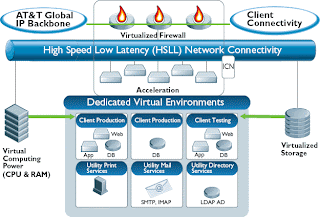 AT&T's Synaptic Hosting is the operator's next-generation utility-computing service with managed networking, security, and storage for business. The new service combines technology acquired from applications service provider USinternetworking with five "super IDCs," or internet data centers (IDCs), across the U.S., Europe, and Asia. Customers receive managed servers, LAN, security, storage, designated account support, and enterprise-class service level agreements.
AT&T's Synaptic Hosting is the operator's next-generation utility-computing service with managed networking, security, and storage for business. The new service combines technology acquired from applications service provider USinternetworking with five "super IDCs," or internet data centers (IDCs), across the U.S., Europe, and Asia. Customers receive managed servers, LAN, security, storage, designated account support, and enterprise-class service level agreements.One the of first announced customers for the AT&T Synaptic Hosting Service is the U.S. Olympic Committee (USOC), which has powered the teamusa.org Website with AT&T Synaptic Hosting. Given the buildup of Website activity leading up to and during the Beijing Olympic games and the subsequent fall-off in activity in the months following the games' conclusion, the flexibility enabled by the utility computing model was ideal for the USOC.
Network operators around the world face tremendous challenges and opportunities as they transform themselves from traditional telcos of the 20th century to the next-generation communications providers of the 21st century. As network services and network traffic migrate from TDM, voice-to-packets, and IP, network operators have no choice but to transform themselves or decline and, ultimately, fail in this new and highly competitive environment. As network operators, the network must play a primary role in this telecom industry transition. Clearly, this explains the unveiling of various network operator NGN initiatives around the world over the past couple of years. At the network level, key requirements for operators to realize this
vision of the future include:
• End-to-end connection and resource management
• Ubiquitous connectivity between networks
• IP-aware transport
• Increased service awareness in access and metro
• Service-aware data, control, and management planes
• High availability
• Network flexibility
• On-demand connection abilities
Despite much talk about NGNs, the industry is still in the early stages of this transformation. We will see a great deal of change over the next decade and beyond. The winning network operators will be those able to successfully embrace today's data/IP growth applications, adapt quickly to deliver the as-yet unknown applications that will drive revenue growth in the future, and build the bridge between legacy TDM and packets, as long as TDM continues to exist in the network.
No comments:
Post a Comment
Type your comment in here